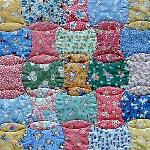America's Quilting History
The Charming History of Charm Quilts
 The charm quilt is known by other interesting names that describe different attributes of this quilt. The name "Odd Feller" reflects the idea that there should be no two identical pieces of fabric in a charm quilt. "Beggar" refers to the fact that women often asked others for bits of fabric in order to collect enough different scraps to complete their quilt.
The charm quilt is known by other interesting names that describe different attributes of this quilt. The name "Odd Feller" reflects the idea that there should be no two identical pieces of fabric in a charm quilt. "Beggar" refers to the fact that women often asked others for bits of fabric in order to collect enough different scraps to complete their quilt.
The very word "charm" indicates that there is a magical aspect to these quilts. Indeed young women of the Victorian era enjoyed collecting buttons and putting them all on a string. The story went that if a girl could collect 999 the young man who would become her true love would bring her the thousandth button. The making of charm quilts is simply a variation of this practice. There is probably some truth to this myth as the very act of collecting would be a delightful reason to ask a eligible young man if he has any odd buttons or scraps from worn out shirts to contribute. Such a conversation could lead to romance.
The other story that has come down over the years about charm quilts is that a mother would make her quilt of different fabrics except for two identical ones. On a large bed quilt it would take a bit of searching to find the matching pair. What a perfect activity for a bored bedridden child recuperating from an illness.

There have been three peaks of interest in making charm quilts. The first was the above mentioned Victorian charm quilts. These quilts tended to have the darker, more somber fabrics of the period. Take a look at this Elongated Hexagon Quilt to see a good example. The charm quilts made in this period were usually made of a single shape called one-patch quilts. Some were made up of squares or triangles. Other more interesting patterns include the Thimble, Honeycomb and Applecore. Any shape that would fit together to make one large flat piece would do.
Charm quilts became popular again in the 1920s as a part of the renewed interest in quilting. By the mid twenties the new lighter fabrics saw their way into charm quilts. Charm quilts of this period tended to have a more ordered look. Sometimes solid fabric was used as sashing or a part of the quilt block in order to give the quilt an organized look. Sorting the varied fabrics into lights and darks using shades of color was another way to avoid the scattered look of the earlier charm quilts. Collecting the needed variety of fabrics during this period was made easier by commercially prepared scrap bags and packages of charm squares.
The third cycle of renewed interest in charm quilts was inspired by the recent Millennium celebration. Quilters have participated in fabric swaps through magazines, friends and that newest form of communication, the Internet. Betty Reynold has a wonderful page on her website showing her Millennium Quilt and telling about the process of making it.
Next time you are browsing through an antique shop or garage sale take a careful look. That ordinary looking scrap quilt may be charmed. It could be a true charm quilt with a wonderful array of period fabrics.
© 2001 Anne Johnson (Do not reproduce any material from this site without permission.)
Reference:
"Clues in the Calico" by Barbara Brackman


